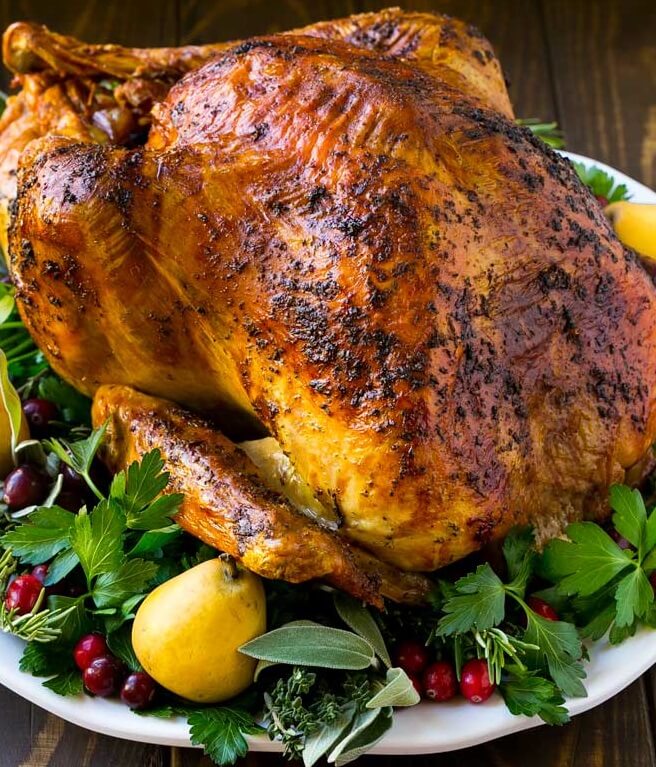Turkey Brine
Even if you didn’t want to do all the extras in the recipe (butter, basting liquid), you can skip everything else and just make the brine. I think you’ll be pleased with the result.
Finding a large-enough container can be a problem; I used my big enamel canning pot but had to double the water in the brine to cover the turkey. Another idea is to use a cooler. I think a new 5-gallon pail with an oven bag inside would work well as long as your turkey fits in the pail! The general rule is to brine it for one hour per pound of meat.
1 pastured turkey, thawed and rinsed
1 medium apple, cut into chunks
1 medium onion, cut into chunks
Container for holding turkey and brine
To Make the Brine:
1 gallon water (up to 2 gallons water can be used without altering the recipe)
1 cup salt
1/2 cup honey
5 bay leaves
1 tablespoon black peppercorns
2 springs fresh sage (or 1 tablespoon dried sage)
2 sprigs fresh thyme (or 1 tablespoon dried thyme)
To Make the Basting Liquid:
1.5 cups broth
1/2 cup apple cider (I used apple juice)
1/4 teaspoon ground black pepper
Garlic Sage Butter Recipe:
5 Tablespoons butter, softened
1/4 cup sage leaves (optional; I skipped this)
2 cloves garlic
Instructions:
1. In a pot on your stovetop, combine the salt, honey, and herbs with 4 cups water. Bring to a simmer and stir until the salt is dissolved. Remove from heat, and mix in the remaining water. Set aside and allow to cool completely.
2. Pour the cooled brine into a large container and add the turkey. (I’ve used food-grade plastic 5-gallon buckets in the past. Or, you can line a large stockpot with a oven bag and place the brine and turkey in the bag.)
3. If the turkey doesn’t want to stay full submerged, or tries to float to the top, weigh it down with a clean plate.
4. Leave the turkey and brine in a cool place for 12-18 hours. If you have room in your fridge, that’s great. I never do, but thankfully it’s always cool enough in the shop. (Just make sure if you’re leaving it outside that it’s not accessible to any curious animals.)
5. After the brining period is complete, pull the turkey out of the brine and rinse under cool water. This will remove the excess brine to make sure the finished bird isn’t too salty. Dry the turkey completely (I use paper towels for this.)
6. Set the turkey on a rack in a shallow roasting pan, breast side up, and stuff it with the apples and onions.
7. In a food processor, combine the softened butter, garlic, and sage. Process until smooth. If you don’t have a food processor, simply mince the garlic and sage with your knife and use a fork to thoroughly mash them into the butter.
8. Use a spatula to gently separate the skin from the meat around the breast and thighs. Stuff generously with garlic sage butter.
9. Tie the legs together with a bit of twine, and tuck the wings close to the body. If you have leftover garlic sage butter, rub it on the turkey’s skin.
10. Pour the basting liquid in the bottom of the pan, cover it all with a lid or tin foil (to keep it from getting too brown), and place in a preheated 325 degree oven.
11. Cooking times will vary, but plan on about 13 minutes per pound. Baste the turkey every 45-60 minutes.
12. The turkey is done when it fills your house with a mouth-watering aroma and your meat thermometer reads 165 degrees when you stick it into the thickest part of the turkey.
13. Allow the turkey to rest for 10-15 minutes before cutting.
14. Some people caution against making gravy with the drippings from a brined turkey, as it can be too salty, but whenever I’ve made this recipe, it results in the most perfect gravy ever. Just be sure to taste it plenty as you make it to check for saltiness– and you can always dilute it with some extra broth if it ends up being a tad on the salty side.
Here is the link to the original recipe. If you try brining your turkey, let me know how it turned out! http://www.theprairiehomestead.com/2015/11/cook-pastured-turkey.html

